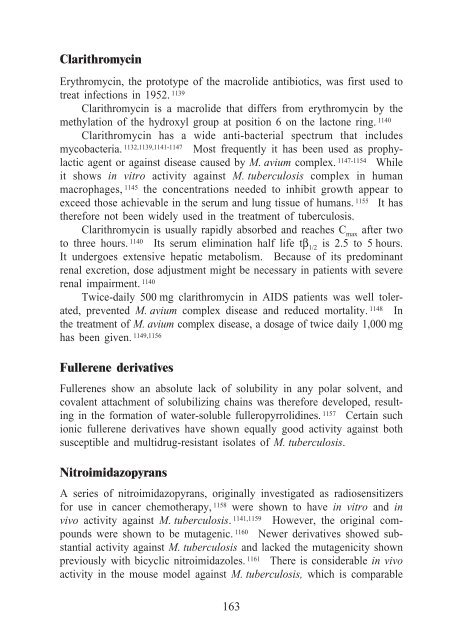Interventions for Tuberculosis Control and Elimination 2002
Interventions for Tuberculosis Control and Elimination 2002
Interventions for Tuberculosis Control and Elimination 2002
You also want an ePaper? Increase the reach of your titles
YUMPU automatically turns print PDFs into web optimized ePapers that Google loves.
Clarithromycin<br />
Erythromycin, the prototype of the macrolide antibiotics, was first used to<br />
treat infections in 1952. 1139<br />
Clarithromycin is a macrolide that differs from erythromycin by the<br />
methylation of the hydroxyl group at position 6 on the lactone ring. 1140<br />
Clarithromycin has a wide anti-bacterial spectrum that includes<br />
mycobacteria. 1132,1139,1141-1147 Most frequently it has been used as prophylactic<br />
agent or against disease caused by M. avium complex. 1147-1154 While<br />
it shows in vitro activity against M. tuberculosis complex in human<br />
macrophages, 1145 the concentrations needed to inhibit growth appear to<br />
exceed those achievable in the serum <strong>and</strong> lung tissue of humans. 1155 It has<br />
there<strong>for</strong>e not been widely used in the treatment of tuberculosis.<br />
Clarithromycin is usually rapidly absorbed <strong>and</strong> reaches C max after two<br />
to three hours. 1140 Its serum elimination half life tβ 1/2 is 2.5 to 5 hours.<br />
It undergoes extensive hepatic metabolism. Because of its predominant<br />
renal excretion, dose adjustment might be necessary in patients with severe<br />
renal impairment. 1140<br />
Twice-daily 500 mg clarithromycin in AIDS patients was well tolerated,<br />
prevented M. avium complex disease <strong>and</strong> reduced mortality. 1148 In<br />
the treatment of M. avium complex disease, a dosage of twice daily 1,000 mg<br />
has been given. 1149,1156<br />
Fullerene derivatives<br />
Fullerenes show an absolute lack of solubility in any polar solvent, <strong>and</strong><br />
covalent attachment of solubilizing chains was there<strong>for</strong>e developed, resulting<br />
in the <strong>for</strong>mation of water-soluble fulleropyrrolidines. 1157 Certain such<br />
ionic fullerene derivatives have shown equally good activity against both<br />
susceptible <strong>and</strong> multidrug-resistant isolates of M. tuberculosis.<br />
Nitroimidazopyrans<br />
A series of nitroimidazopyrans, originally investigated as radiosensitizers<br />
<strong>for</strong> use in cancer chemotherapy, 1158 were shown to have in vitro <strong>and</strong> in<br />
vivo activity against M. tuberculosis. 1141,1159 However, the original compounds<br />
were shown to be mutagenic. 1160 Newer derivatives showed substantial<br />
activity against M. tuberculosis <strong>and</strong> lacked the mutagenicity shown<br />
previously with bicyclic nitroimidazoles. 1161 There is considerable in vivo<br />
activity in the mouse model against M. tuberculosis, which is comparable<br />
163

















